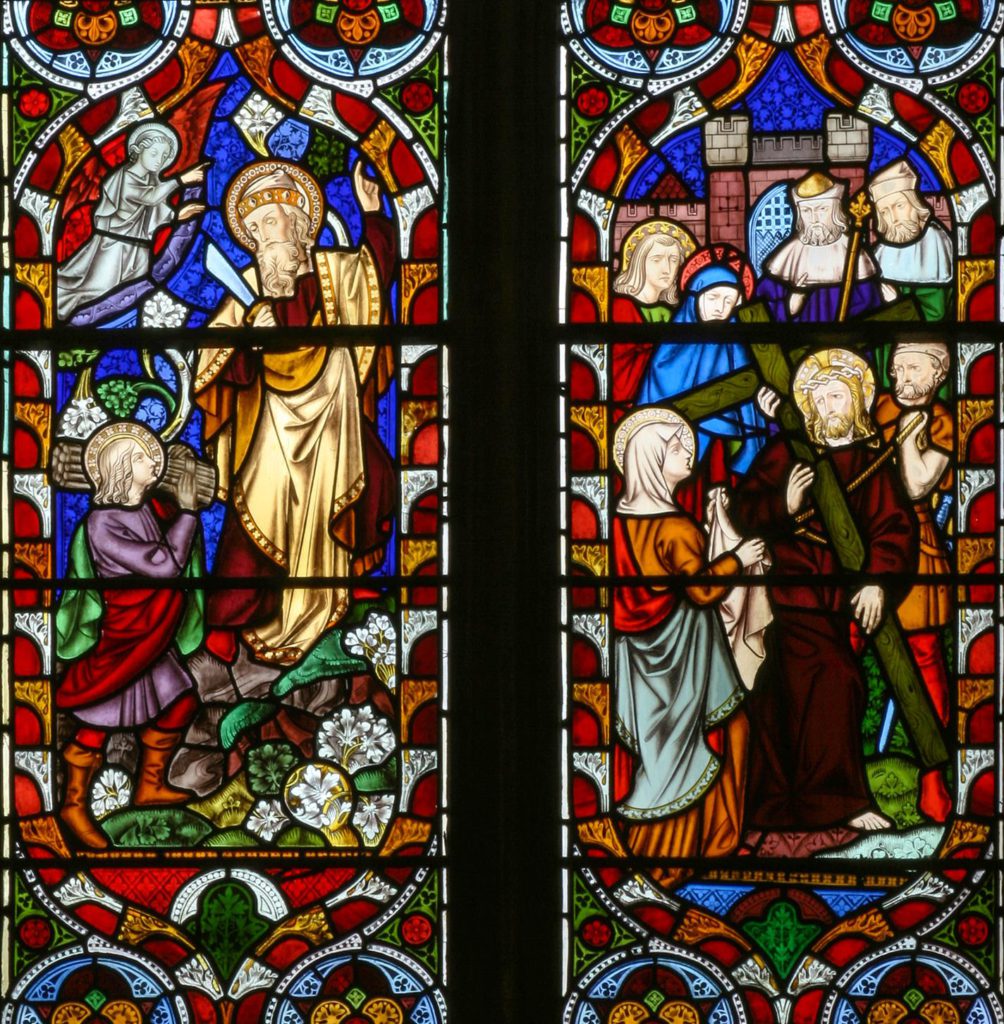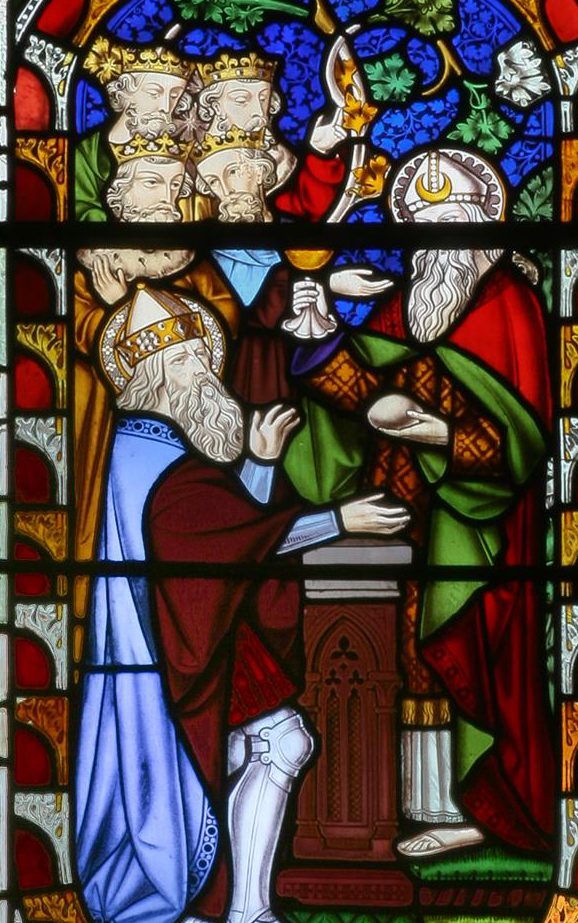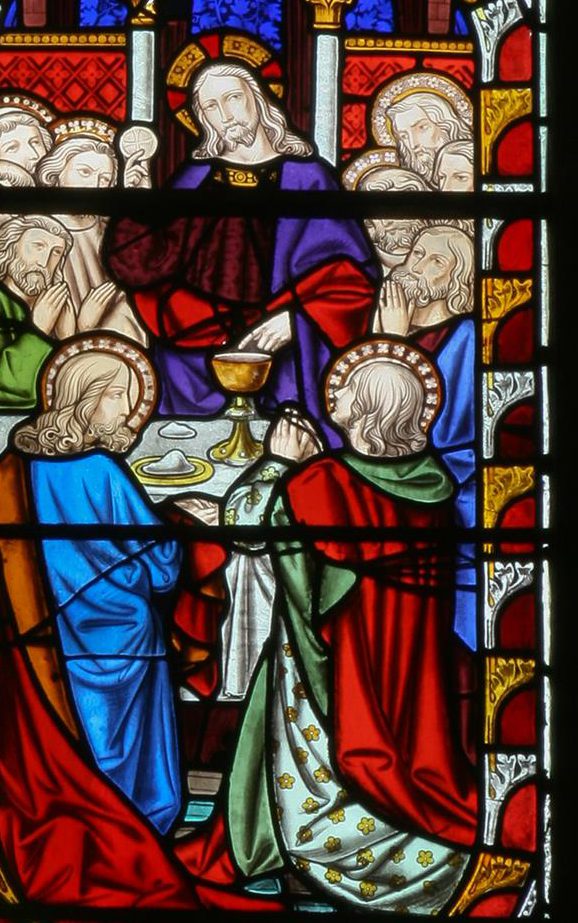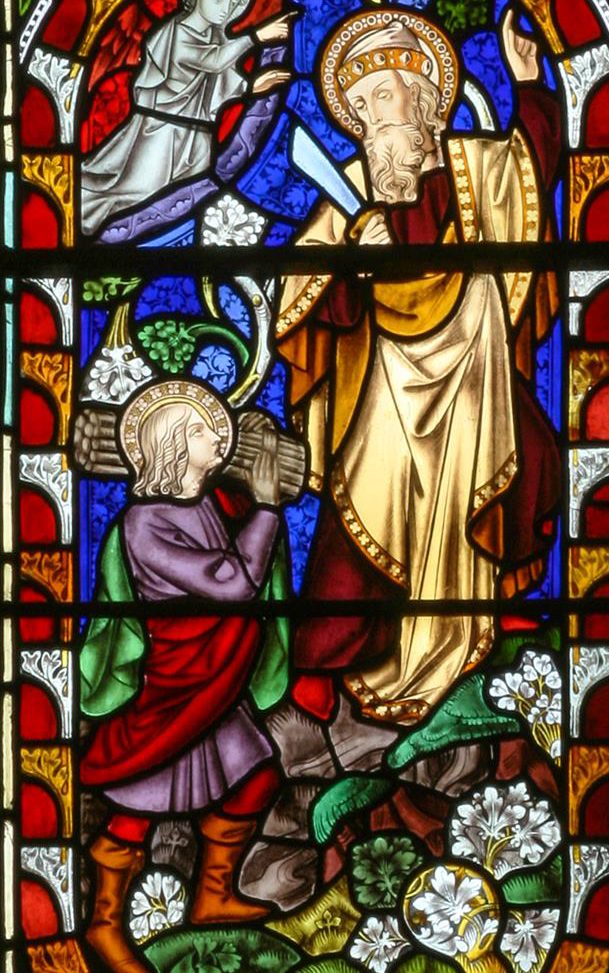
Melchizedek and the Eucharist

The enigmatic Old Testament character Melchizedek (Melchisedech) and the father of the Jewish and Christian faith, Abraham, feature in panel 5.
Melchizedek holds bread and wine in his hands as he blesses Abram – as Abraham was initially known – following Abram’s victory over King Chedorlaomer of Elam (a kingdom in the west of modern-day Iraq).
Panel 6, meanwhile, shows Christ, blessing bread and wine at the Last Supper to institute the Christian Eucharist, meaning ‘Thanksgiving’ also known as ‘Holy Communion’ and the ‘Lord’s Supper.’
Melchizedek appears in the first book of the Old Testament, Genesis (Genesis 14:18-20).
In Hebrew, his name means ‘King of Righteousness.’ Melchizedek is also described as King of Salem – which means ‘shalom’ or ‘Peace’ and can also be interpreted as an earlier name for Jerusalem.
Last, but no means least, Melchizedek is also a priest of El Elyon – often translated as “Most High God,” a description used in the Book of Psalms to refer to the God of Israel.
Melchizedek blesses Abram and receives tribute from him – a tenth of the spoils from the defeat of King Chedorlaomer and his supporters – a sign that Melchizedek is Abram’s superior.
The priest makes his second Biblical appearance in the Book of Psalms (Psalm 110: 4).
The author of the Letter to the Hebrews in the New Testament uses this to link Christ and Melchizedek (Hebrews Chapters 5 to 7), asserting that Melchizedek was “Without father, without mother, without genealogy, having neither beginning of days nor end of life, but resembling the Son of God, he remains a priest for ever.”
His conclusion is that Melchizedek’s priesthood precedes and is superior to the Jewish priesthood and that King David’s royal line – which included Jesus – was directly linked to the priest-kingship of Melchizedek.
Melchisedech is interpreted as a model for Christ and his blessing pre-figures Christ’s action at the Last Supper, as described in the Gospels of Matthew, Mark and Luke. (Matthew 26: 26-28, Mark 14: 22-24 and Luke 22: 19-20)

Sacrifice – Isaac as a ‘model’ for Jesus

The parallels between Abraham offering to prove his faith in God by sacrificing his only son (Panel 7) and Jesus’ willingness to sacrifice himself to save humanity (Panel 8) are more numerous and complex than any of the other Typological connections illustrated in the West Window.
The Sacrifice of Isaac can be found in Genesis 22: 1-19. In summary, God tests Abraham by telling him to take his only son, Isaac, to the land of Moriah, kill him and offer him to God as a burnt offering.
When they reach the place God has chosen, Abraham builds an altar, ties up his son and prepares to sacrifice him, whereupon the Angel of the Lord tells Abraham not to kill his son.
Abraham looks up, sees a ram caught in a thicket, which he kills and offers as a burnt offering in the place of his son.
Panel 7 shows the scene described in Genesis 22: 6.
“Abraham took the wood of the burnt-offering and laid it on his son Isaac, and he himself carried the fire and the knife.
So the two of them walked on together.“The neighbouring panel shows Christ carrying his cross to the place of crucifixion and illustrates an apocryphal meeting with Saint Veronica, who, according to tradition, gave Christ her veil so that he might wipe his forehead.
Christ is said to have accepted the offering, held the cloth to his face and, when he handed it back an image of his face miraculously appeared on the material.
The panel also includes images of his mother, the Virgin Mary and the Disciple who stood at the foot of the cross with her and afterwards took her into his home to care for her. Although the event depicted is not mentioned in the Bible, the Gospel of Luke offers the most detailed description of Christ’s journey. Luke 23: 26-32.
So what are the connections between Isaac and Jesus? The most obvious is that both were to be sacrificed. Of course, God stops the sacrifice of Isaac, but provides an alternative – a ram – while Jesus is referred to – initially by John the Baptist – as the “Lamb of God” who takes away the sins of the world.
The birth of both Isaac and Jesus were miraculous – Isaac was born to a woman thought to be in her 90s (Genesis 21:2) while Christ was born to a virgin.
Both Isaac and Jesus were named by God: Genesis 17:19 – Sarah… shall bear you a son, and you shall call his name Isaac.” and Matthew 1:21 – “[Mary] shall bring forth a Son, and you shall call His name Jesus.”
Isaac and Jesus also carry the wood necessary for the sacrificial offering – firewood for a burnt offering in the case of Isaac and the cross beam of the crucifix in Jesus’ case.
Both were also loved by their fathers and submitted to their fathers’ will and even the location of their death – Moriah and Golgotha/Calvary are claimed to be the same place.
The parallels are said not to end there. Some will quote 30 or more ways in which Isaac’s experience foreshadows Jesus’ death on the cross, although some of the claimed links are of a more tenuous or speculative nature – Jesus goes to his crucifixion with two companions – the two thieves – while Isaac goes to be sacrificed with two servants, being one example.





